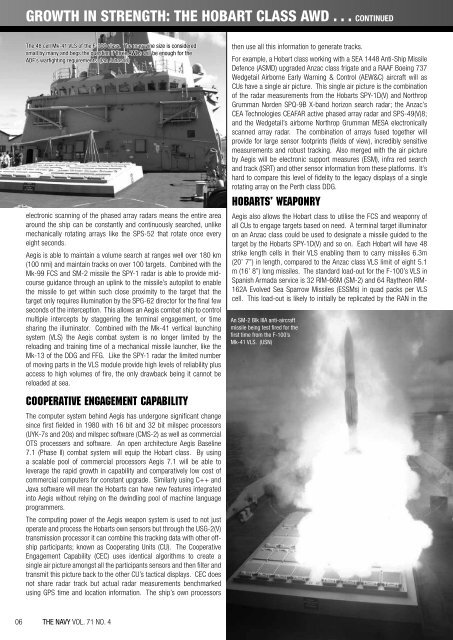VOL 71 No4 - Navy League of Australia
VOL 71 No4 - Navy League of Australia
VOL 71 No4 - Navy League of Australia
Create successful ePaper yourself
Turn your PDF publications into a flip-book with our unique Google optimized e-Paper software.
GROWTH IN STRENGTH: THE HOBART CLASS AWD . . . CONTINUED<br />
The 48 cell Mk-41 VLS <strong>of</strong> the F-100 class. The magazine size is considered<br />
small by many and begs the question if three AWDs will be enough for the<br />
ADF’s warfighting requirements. (Ian Johnson)<br />
electronic scanning <strong>of</strong> the phased array radars means the entire area<br />
around the ship can be constantly and continuously searched, unlike<br />
mechanically rotating arrays like the SPS-52 that rotate once every<br />
eight seconds.<br />
Aegis is able to maintain a volume search at ranges well over 180 km<br />
(100 nmi) and maintain tracks on over 100 targets. Combined with the<br />
Mk-99 FCS and SM-2 missile the SPY-1 radar is able to provide midcourse<br />
guidance through an uplink to the missile’s autopilot to enable<br />
the missile to get within such close proximity to the target that the<br />
target only requires illumination by the SPG-62 director for the final few<br />
seconds <strong>of</strong> the interception. This allows an Aegis combat ship to control<br />
multiple intercepts by staggering the terminal engagement, or time<br />
sharing the illuminator. Combined with the Mk-41 vertical launching<br />
system (VLS) the Aegis combat system is no longer limited by the<br />
reloading and training time <strong>of</strong> a mechanical missile launcher, like the<br />
Mk-13 <strong>of</strong> the DDG and FFG. Like the SPY-1 radar the limited number<br />
<strong>of</strong> moving parts in the VLS module provide high levels <strong>of</strong> reliability plus<br />
access to high volumes <strong>of</strong> fire, the only drawback being it cannot be<br />
reloaded at sea.<br />
COOPERATIVE ENGAGEMENT CAPABILITY<br />
The computer system behind Aegis has undergone significant change<br />
since first fielded in 1980 with 16 bit and 32 bit milspec processors<br />
(UYK-7s and 20s) and milspec s<strong>of</strong>tware (CMS-2) as well as commercial<br />
OTS processers and s<strong>of</strong>tware. An open architecture Aegis Baseline<br />
7.1 (Phase II) combat system will equip the Hobart class. By using<br />
a scalable pool <strong>of</strong> commercial processors Aegis 7.1 will be able to<br />
leverage the rapid growth in capability and comparatively low cost <strong>of</strong><br />
commercial computers for constant upgrade. Similarly using C++ and<br />
Java s<strong>of</strong>tware will mean the Hobarts can have new features integrated<br />
into Aegis without relying on the dwindling pool <strong>of</strong> machine language<br />
programmers.<br />
The computing power <strong>of</strong> the Aegis weapon system is used to not just<br />
operate and process the Hobarts own sensors but through the USG-2(V)<br />
transmission processor it can combine this tracking data with other <strong>of</strong>fship<br />
participants; known as Cooperating Units (CU). The Cooperative<br />
Engagement Capability (CEC) uses identical algorithms to create a<br />
single air picture amongst all the participants sensors and then filter and<br />
transmit this picture back to the other CU’s tactical displays. CEC does<br />
not share radar track but actual radar measurements benchmarked<br />
using GPS time and location information. The ship’s own processors<br />
then use all this information to generate tracks.<br />
For example, a Hobart class working with a SEA 1448 Anti-Ship Missile<br />
Defence (ASMD) upgraded Anzac class frigate and a RAAF Boeing 737<br />
Wedgetail Airborne Early Warning & Control (AEW&C) aircraft will as<br />
CUs have a single air picture. This single air picture is the combination<br />
<strong>of</strong> the radar measurements from the Hobarts SPY-1D(V) and Northrop<br />
Grumman Norden SPQ-9B X-band horizon search radar; the Anzac’s<br />
CEA Technologies CEAFAR active phased array radar and SPS-49(V)8;<br />
and the Wedgetail’s airborne Northrop Grumman MESA electronically<br />
scanned array radar. The combination <strong>of</strong> arrays fused together will<br />
provide for large sensor footprints (fields <strong>of</strong> view), incredibly sensitive<br />
measurements and robust tracking. Also merged with the air picture<br />
by Aegis will be electronic support measures (ESM), infra red search<br />
and track (ISRT) and other sensor information from these platforms. It’s<br />
hard to compare this level <strong>of</strong> fidelity to the legacy displays <strong>of</strong> a single<br />
rotating array on the Perth class DDG.<br />
HOBARTS’ WEAPONRY<br />
Aegis also allows the Hobart class to utilise the FCS and weaponry <strong>of</strong><br />
all CUs to engage targets based on need. A terminal target illuminator<br />
on an Anzac class could be used to designate a missile guided to the<br />
target by the Hobarts SPY-1D(V) and so on. Each Hobart will have 48<br />
strike length cells in their VLS enabling them to carry missiles 6.3m<br />
(20’ 7”) in length, compared to the Anzac class VLS limit <strong>of</strong> eight 5.1<br />
m (16’ 8”) long missiles. The standard load-out for the F-100’s VLS in<br />
Spanish Armada service is 32 RIM-66M (SM-2) and 64 Raytheon RIM-<br />
162A Evolved Sea Sparrow Missiles (ESSMs) in quad packs per VLS<br />
cell. This load-out is likely to initially be replicated by the RAN in the<br />
An SM-2 Blk IIIA anti-aircraft<br />
missile being test fired for the<br />
first time from the F-100’s<br />
Mk-41 VLS. (USN)<br />
06 THE NAVY <strong>VOL</strong>. <strong>71</strong> NO. 4

















